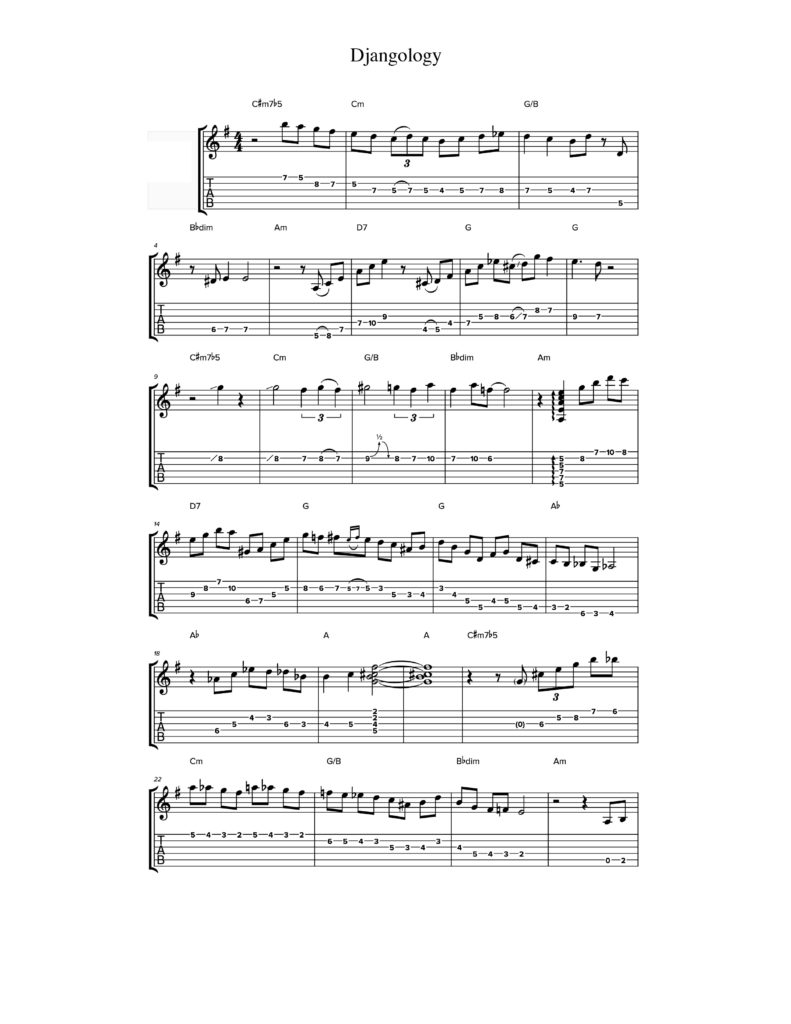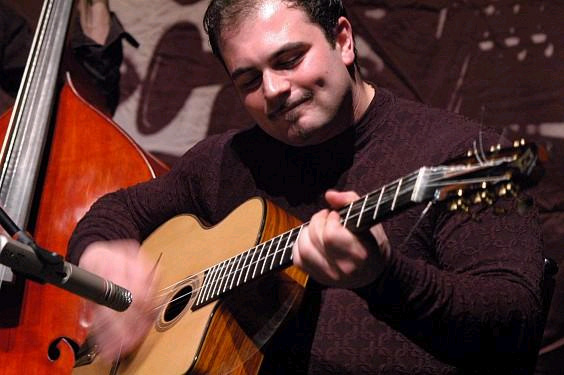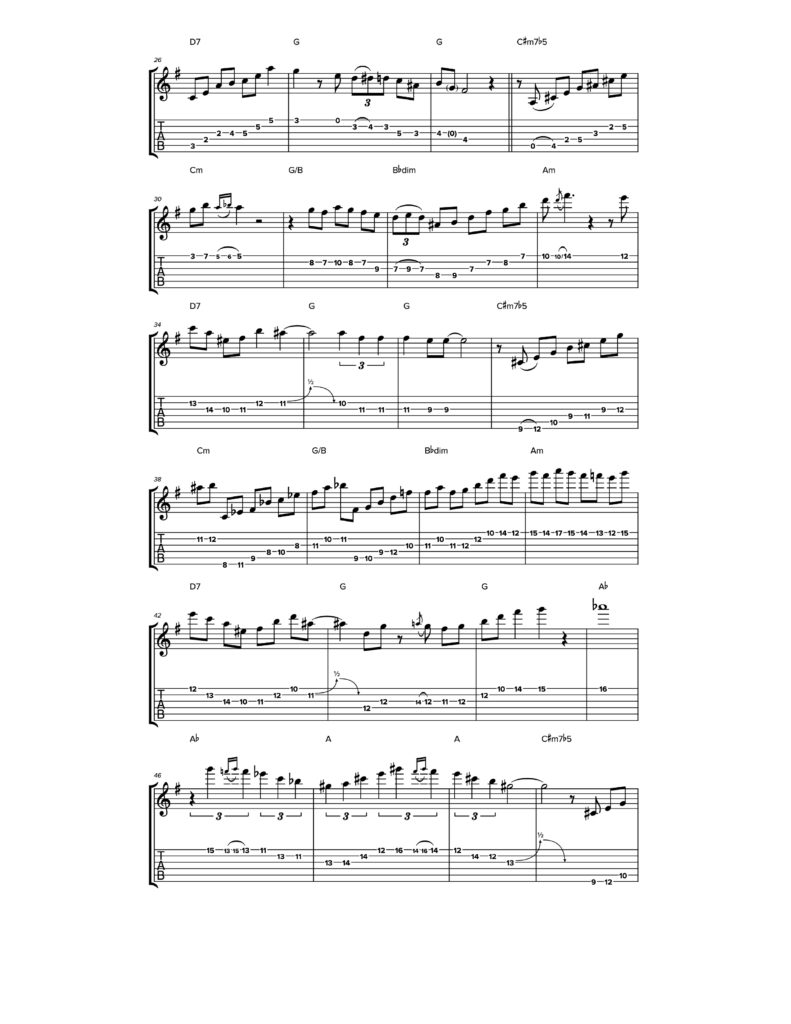by Denis Chang
As a way to thank DjangoBooks.com for always allowing me to advertise my Soundslice (https://www.soundslice.com/users/DenisChang/) and DC Music School (www.dc-musicschool.com) products on his forum, I am happy to offer this series of mini lessons where we will be looking at a number of improvisations on the tune Djangology. These performances were made for DC Music School and the actual lessons come up with detailed transcriptions.
In this lesson, I will be analyzing each solo phrase by phrase so that you can hopefully understand how to make your own analyses. Every improviser has their own style, their own method of interpreting chord changes. A term that I have been using lately is “Harmonic Direction”; it’s a term I came up with to describe where the harmony is going. This has a tremendous effect on how we approach phrasing. Every great improviser has their own way of interpreting Harmonic Direction.
This is a skill acquired by learning as many songs as possible by heart, so that you begin to recognize chord progressions, common patterns, and common resolutions. Listen to different versions of the same song so that you can become exposed to different harmonic possibilities and thus different harmonic pathways that eventually resolve to the same chord. This is what I mean by Harmonic Direction. Then, by paying attention to the improvisor’s solos, we can begin to see which harmonic pathways they tend to favor. Which chords are emphasized? which chords are ignored? Which substitutions over which chords are used?
Let’s get started!

Samson Schmitt – From In The Style of Samson Schmitt, available at DC Music School (comes with the transcription).
The first phrase from bars 1 to 3 is inspired by Django Reinhardt’s solo on the same song when he was in Rome. The first bar is a scalar pattern that emphasizes an A7 chord. In this case, it’s more important to understand which chord tones are being emphasized than which scale he is thinking about. In this case, the notes are the 9th, the root, the flat 7th, and the 13th of an A7 chord. One could argue that it’s the A Mixolydian scale, and it wouldn’t be wrong, but these same 4 notes being emphasized are also part of the G major scale. Since this is Django’s idea, I would dare make the claim that he is thinking more about these very chord tones than a very specific scale (whether A Mixolydian or G major).
By the second bar, the scalar idea continues but is slightly modified to fit the Cm chord. On the first beat, the E natural is actually still part of the A7 chord. Most improvisors play in the moment, so lines don’t always line up perfectly with each chord change and this would be a prime example of this. My rule is: “did it sound terrible?”. Chances are if you are casually listening, you likely wouldn’t be bothered by this “mistake”. Furthermore, the note is in passing so the dissonance is less noticeable.
These first two bars are the reason, I’d rather not analyze the lines in terms of specific modes changing from chord to chord. He knows he is in the key of G, and that certain notes of the G major scale can be modified to fit these non-diatonic chords. He is most definitely not thinking A Mixolydian to C Dorian or anything like that.
The third bar concludes the first phrase by outlining a G chord. The fourth bar emphasizes the note E which fits perfectly over a Bbdim chord, and also happens to be a common tone with the G major scale, which further proves my point about just thinking in terms of the key of G and then making small changes if necessary to fit the chord.
Bars 5-8 conclude the first A with Am and D7 arpeggios resolving to G. On the D7, he makes use of the flat 9 tension (borrowed from the Gm tonality).
The second A follows the same idea of using the G major scale but specifically using the notes that fit the harmonies. On bar 12, over Bbdim7, he is thinking Bm to Bbm (2 beats each) to Am. This is a substitution that Django liked to use in the 1940s. The basic idea is to treat the G/B as a Bm. This works perfectly because Gmaj7 is essentially a Bm with a G bass. Since Bm eventually leads to Am, we connect the two chords chromatically with a Bbm. So in this case, the soloist is not thinking of Bbdim at all.
The II V I phrase that concludes the second A basically outlines an Am chord. The Am idea is extended over to the G chord, and the resolution is slightly delayed. Again, the improvisor is playing in the moment, and these things happen. A great lesson to be learned here: lines don’t have to perfectly line up from chord to chord. If anything, it can be interesting to experiment with over the barline phrasing.
The B section is the same: he is finishing his G major phrase and resolves to Ab by the 3rd beat.
He begins the next phrase on measure 18 with another idea based on the Ab chord and chromatically voice leading his way into the A chord, ending the phrase with an A13 chord stab. You may ask “isn’t it supposed to be A major instead of A7”? Yes, but the beauty of harmonic interpretation is that you can do what you want. He is forcing the dominant sound onto the A major chord. Luckily, the rhythm player (me) is playing a simple A triad so it works out without any kind of dissonance.
The final A of the first chorus begins with an arpeggio emphasizing an A9 chord. It should be noted that an A9 chord without the A is actually just a C#m7b5 chord. Bar 22 to the first half of bar 23 is a guitaristic chromatic pattern. Nothing to over intellectualize here. He resolves the chromatic pattern with a phrase that clearly outlines a G major chord. The Bbdim chord is ignored here but he does end the phrase on the note E which is a chord tone.
The first chorus ends with a simple Am arpeggio over the II V resolving to G.
The second chorus begins with an A7 arpeggio emphasizing an A9 chord, the arpeggio and phrase continue onto the second bar which is the Cm chord. It just so happens that that these last notes of the A9 arpeggio happen to be common tones with Cm. The lesson to learn here is rather than very deliberately changing arpeggios, see if you can find notes that are in common between two different chords. This is the reason why over a II V, many players just play II (Am over both Am and D7).
Bars 31 to 32 outline a G major chord. The Bbdim is definitely ignored here. The A section ends with a typical Django II V I phrase. Notice that on the G resolution, the maj7th and 6th are emphasized. This is very typical of the style.
The second A begins with a succession of arpeggios outlining the first three chords but once again the phrasing doesn’t line up perfectly with each chord change. The first arpeggio is a C#m7b5, the second arpeggio is the same arpeggio but down a semi-tone. There are many ways to intellectualize such a choice over a Cm chord but it’s probably best just to say that he’s playing in the moment and it sounded good at that time. However, if you desperately need a logical answer, one could argue that the first two chords of Djangology are essentially a II V I to G. The II is made into a secondary dominant (A7 instead of Am), and the V is replaced by a IVm (typical substitution in jazz music). So if we reverse engineer things to its original state, instead of Cm we have D7. Cm7b5 over D7 happens to outline D altered. Therefore, this Cm7b5 works well!
Bars 39-40 once again ignored the Bbdim chord as Samson simply outlines a G major chord. The second A concludes with a typical Django inspired II V I.
The B section is not complicated at all as he simply outlines the chords in a clear manner. The one thing to pay attention is how he voice leads Ab to A.
The final A begins with yet another C#m7b5 arpeggio. This time, however, it starts late and the Cm is largely ignored until beat 4 where he emphasizes the note Bb which outlines Cm7.
Bars 51 and 52 outline a G major chord. Once more, the Bbdim is ignored. The solo ends with another II V I phrase that shouldn’t be too difficult to understand.
A few extra things to observe:
Pay attention to the phrasing. As we have seen, lines don’t always perfectly line up with the harmonies. Often he groups certain chords together into one single phrase. For instance the first two bars are basically one single phrase that resolve in the third bar. An obvious grouping of chords would be II V I.
Pay attention to how scales are used. As I mentioned earlier, I don’t think it’s a good idea to think in terms of modes or chord scales for this kind of music because that is definitely not what the vast majority of the players in this style are thinking about. Know which key you’re in, and then maybe study the parent scale (in this case G major), but beyond that, make modifications here and there to fit the chords as they come by. It’s also not about playing entire scales but to choose small fragments. Choose the ones where you don’t have to modify too many notes. For instance, over C#m7b5, Cm to G, the notes F# G A B work wonderfully. They are all part of the G major scale, but they fit all three chords! From G until the end of the A section, the notes E F# G A work as well!











